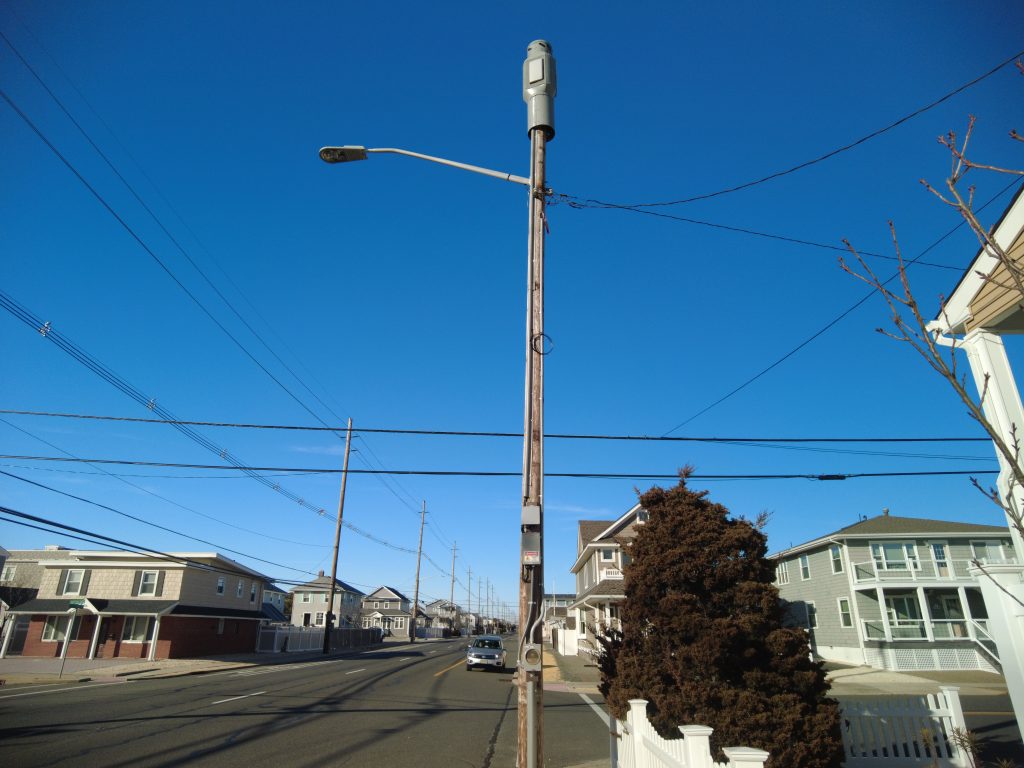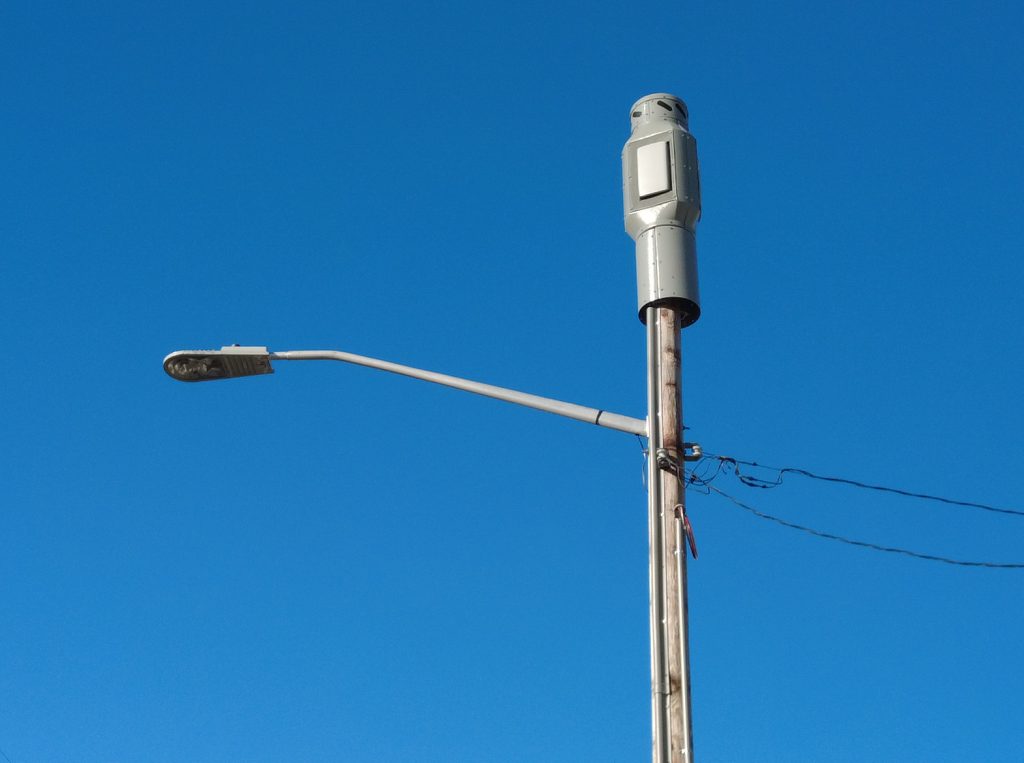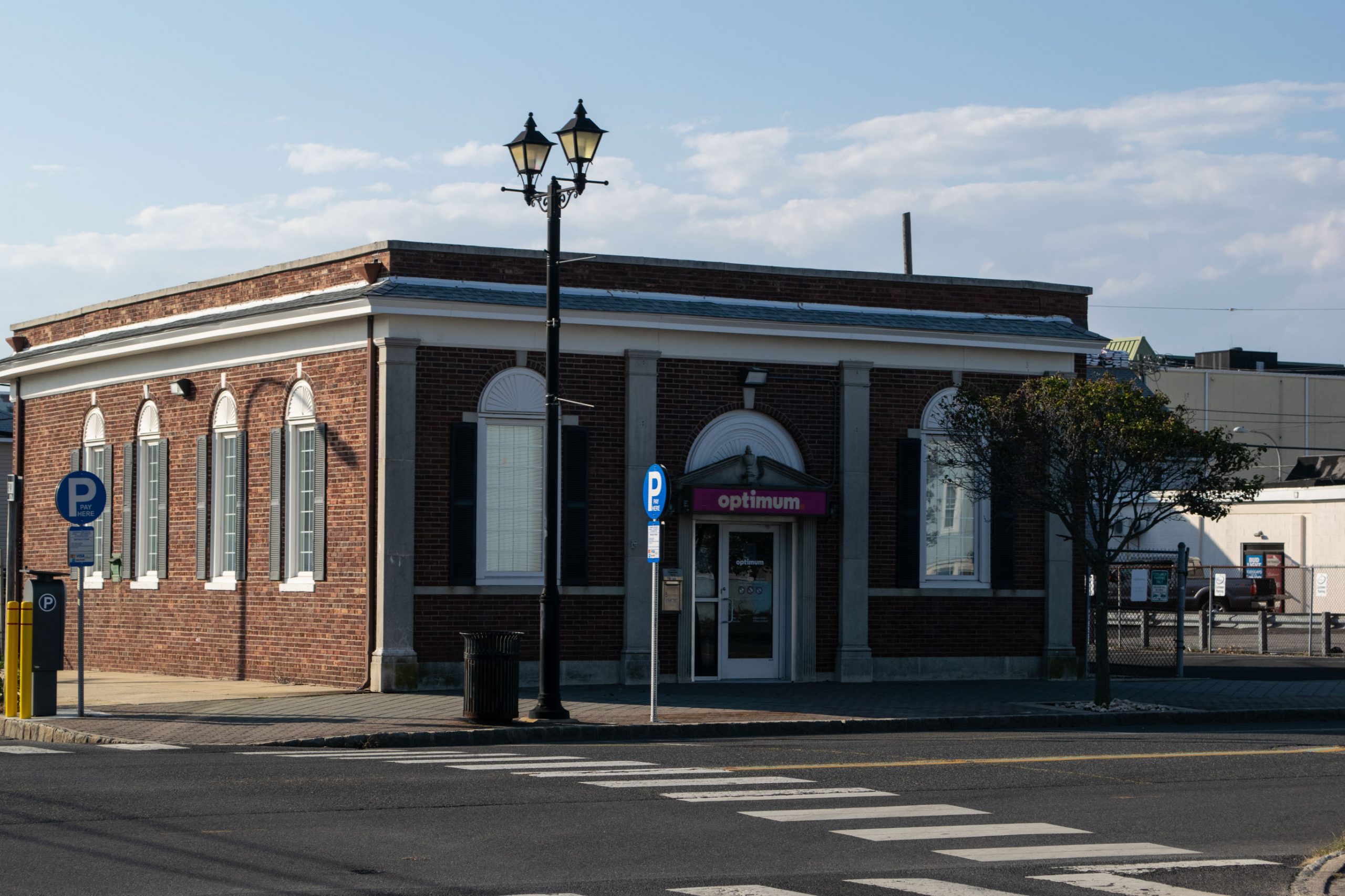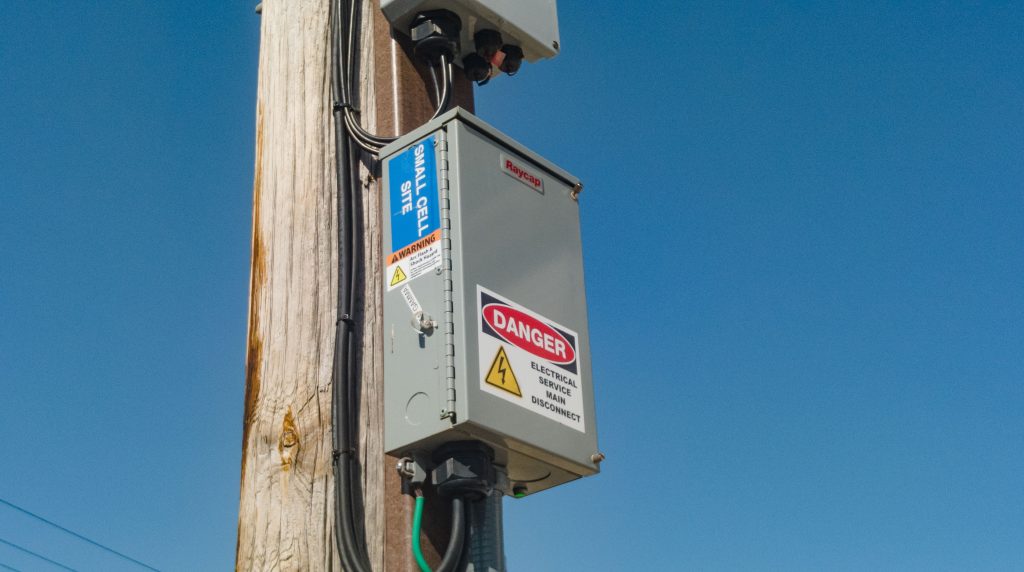
A small 5G wireless facility on top of an existing timber pole, Lavallette, N.J., May 2023. (Photo: Shorebeat)
Lavallette officials, following an otherwise efficient meeting of the borough council that turned into a nearly five hour-long slog as they battled with representatives from Verizon, voted 4-1 to deny the wireless provider permits to grow its ever-expanding network of “small cell” network nodes around town, setting the stage for a legal battle that will rival those in other parts of New Jersey and the United States.
Verizon’s proposal to construct six additional network nodes on new and existing utility poles was rejected by the borough’s planning board last month, but the fate of the company’s pitch ultimately fell to the borough council, which is the only body that maintains the power to actually issue permits for construction. Arguing that Verizon was disproportionately flooding the town with antennas, installing heavy loads on utility poles that were prone to leaning, misleading residents and officials about their locations and providing little to no explanation as to why so many towers seemed to be required in Lavallette versus neighboring communities, the governing body could not muster a second when asked to vote on the applications. Instead, a motion for denial of the permits carried the night, with only Council President Anita Zalom voting against the denial. Councilman David Finter abstained due to a conflict of interest since he worked for Verizon.
Edward W. Purcell, the attorney representing Verizon, made a statement before the vote, vaguely referencing the supposition that the matter would be determined by a federal judge if it was not resolved at borough hall.
“These installations are taking place all over the Jersey Shore,” Purcell said. “The need here is acute and without these nodes there is not going to be sufficient service during the summer months. It is imperative that Verizon be able to provide the services we need to provide.”
Is There Something About Lavallette?
The sheer number of antennas already approved and proposed in Lavallette, now up to 16, dwarfs that of nearly every other Jersey Shore town, with exception of Belmar, where 20 new poles had been proposed along the town’s boardwalk. That case also fell into litigation after a denial.
Officials were prepared with statements from municipal administrators from other towns up and down the barrier island, indicating a small number of antennas having been approved and proposed for locations in their towns. Most had two or three, compared to Lavallette’s proposed 16 – which was subject to grow even further with future applications. Mayor Walter LaCicero pressed Verizon officials for an answer as to why Lavallette, as opposed to neighboring communities with arguably more summer visitors, was the subject of so many antenna permit applications. In one case, while showing a chart of wireless activity spikes, the Seaside Heights St. Patrick’s Day Parade was shown as one of the peak dates, kicking off a discussion as to why so much antenna development was centered in Lavallette.
“Density in Ocean Beach is much higher than in Lavallette,” said LaCicero. “There are way more people there than here. I don’t understand why all of this is clustered in Lavallette. Why would it not be spread around?”
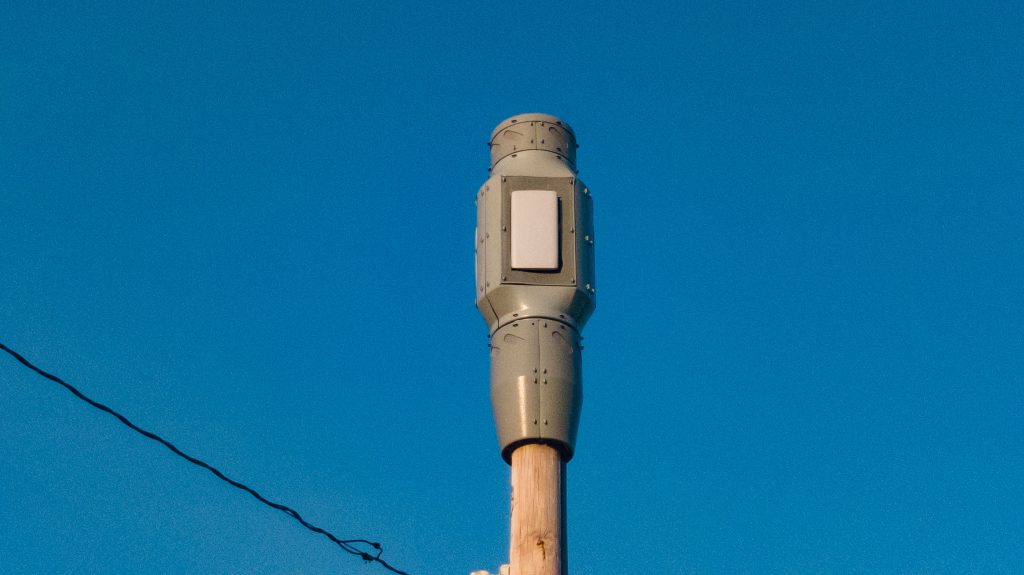
A small 5G wireless facility on top of an existing timber pole, Lavallette, N.J., May 2023. (Photo: Shorebeat)
A radiofrequency engineer hired by Verizon told board members that “macro” antennas – the type located on top of water towers or large monopoles – provided better coverage of both 4G and 5G network services to those areas. He also said Verizon’s status as a legacy carrier, dating back to the days of Bell Atlantic and NYNEX, meant the company needed the small cell nodes since mergers and acquisitions from younger companies such as T-Mobile and the current iteration of AT&T, benefited from additional frequency spectrum through various mergers and acquisitions over the years. Meanwhile, Verizon has bid on new frequency spectrum, but splits its 4G and 5G networks between them, requiring street-level networks to deliver millimeter-wave signals carrying extremely fast data speeds to customers.
The frequencies being utilized by Verizon’s 5G network, compared to others, are better served by the pole-mounted antennas.
“From a spectral position, if we talk about T-Mobile, they have a much different spectral footprint,” he said. “We haven’t had the mergers that would benefit our spectral outlay except for the auctions that we’ve participated in.”
Issues Upon Issues
While radiofrequency emissions from cellular antennas, an issue prone to debate as well as occasional conspiracy theories, took up part of the night’s discussion, much of it centered on the poles themselves. A report from Verizon assumed several of the poles in proposed locations – despite leaning to one direction – could handle more than 435 pounds of equipment that the company would attach to them. Councilwoman Joanne Filippone, a staunch opponent of the small cell network deployment in town, cautioned Verizon officials that numerous automobile accidents have brought down poles in recent years, and at least one of the poles proposed by the company was located in an area where large vehicles access the beach and must drive in reverse on a frequent basis.
“The integrity of these poles is questionable,” said Filippone.
“With the pole, the additional dead-load is not the deciding factor,” replied Colleen Connelly, an engineer representing Verizon. “Our analysis accounts for the pole, the equipment on it, the lines that are supporter by that pole, and ice accumulating on the wires and the equipment.”
Describing a leaning pole on White Avenue where both 4G and 5G equipment was being proposed, the position of the existing pole would not cause a danger, she said.
“While it has a slight lean to it, it’s not an end pole,” she said. “So we believe what was there is significant enough.”
When Verizon began proposing the “small cell” antennas on top of existing poles – and some replacement poles if the integrity of an existing pole was insufficient – many believed it was to carry equipment for the deployment of 5G network infrastructure. But the company has since acknowledged that the small cells also carry 4G signals. Each set of antennas – 4G and 5G – weight hundreds of pounds, and are located on different positions on the utility pole. A “shroud” weighing more than 100 pounds is generally placed on top of the 5G antenna for aesthetic improvements, however the bright gray color of the shrouds has led to many complaints, given that they brightly contrast with the wooden utility poles on which they are mounted.
The small cell antennas, the engineer testified, share a 5G signal at a maximum of about 1,000 feet, and significantly less for 4G applications. The company would not rule out applications for even more antennas in the future.
“That would mean one of these nodes would be everywhere,” said Councilman James Borowski.
Further, Filippone argued that Verizon had proposed several towers at addresses that did not actually exist, effectively estimating where the poles might be rather than designating a specific location. She held the confusion over addresses violated the due process of residents who may have objected to antennas being placed outside their homes without having been notified.
The poles were officially proposed to be located at:
- 72 Oceanfront (revised)
- 2 President (revised)
- 122 Newark Ave. (new plan)
- 100 Oceanfront (revised)
- 110 White Ave. (revised)
- 506 Oceanfront (revised)
Lack of Support
Purcell insisted on the record that Lavallette was not being singled out or treated any differently than any other Shore community. Its geography, he said, necessitated the small cell antenna network since there were fewer opportunities to carry high-speed frequencies on tall-mounted arrays such as water tanks and large poles.
“These facilities are required by Verizon to provide additional capacity and service to Lavallette,” he said. “Without capacity, calls are dropped and texts can’t go through. This is obviously a problem for people on the beach, or here on the weekends, and this is something this is intended to ameliorate.”
Purcell referenced a news article from the summer listing Lavallette as New Jersey “ninth most desirable beach” as a testament to the influx of crowds the company has to deal with. But the sticking point for officials remained the fact that out of all of the wireless providers that exist, only Verizon has submitted proposals for small cell sites, and there was no guarantee that the current 16 would end the seemingly continual proliferation.
“New Jersey has 52 Shore municipalities,” said Purcell. “Of those, 31 have on-air small nodes. In Monmouth, Ocean and Atlantic counties, there are 301 small cells on air. There are a fair amount of these facilities located across the state.”
Purcell’s arguments did not sway the governing body, however, resulting in the denial.
William Burns, the borough attorney, said a resolution memorializing the council’s decision would be drawn up and formally voted upon at the next council meeting, scheduled for Dec. 4. It is unknown if the borough will continue any discussions with Verizon between now and then. Twice during Monday’s meeting, the council adjourned into executive session to discuss the matter with Burns.
For now, however, a decision has been rendered – and the seven new, proposed antenna arrays are not permitted in the borough.

Advertisement

Police, Fire & Courts
Police Investigating Possible Shots Fired in Seaside Heights

Police, Fire & Courts
Cops: Juvenile Arrested After 118mph Joy Ride in Seaside Heights, Toms River Kills 2

Seaside Heights & Seaside Park
Seaside Heights Mourns Passing of Boardwalk Legend, Still Working Into His 90s

